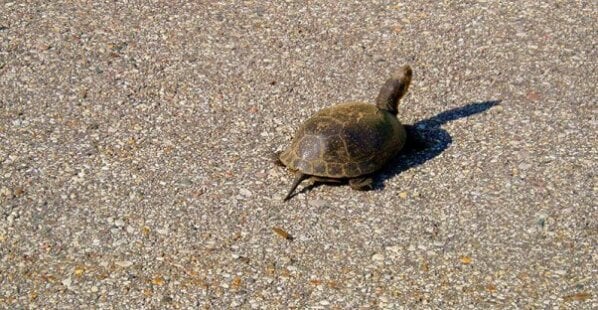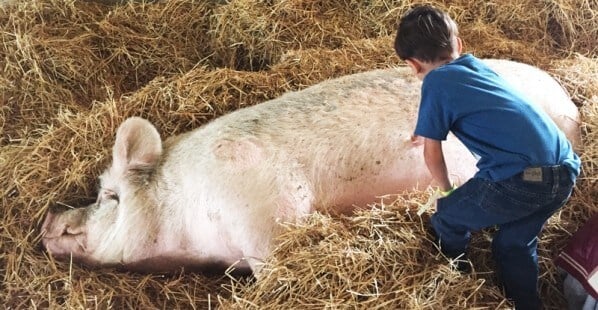How to Treat Animals You See at the Park With Kindness
When you go to the park with your family to enjoy a vegan picnic surrounded by nature, you’ll probably see a lot of animals there. You might notice a family of ducks swimming across the lake, be visited by a curious squirrel or two, or even feel a tickle when an ant becomes separated from their family and finds your foot! Compassionate kids like you know not to crush bugs or chase birds and mammals because it can scare them, but do you know other ways to be kind to animals?
Here are some interesting facts about the ones you might see at the park and ways to be a polite guest in their outdoor homes the next time you visit:
Swans, Geese, and Ducks
If you’re at a park with a lake in it, you’ll likely see lots of birds who love the water—like swans, geese, and ducks. These birds have a lot in common with each other (and with humans!). For example, once swans and geese choose a mate, they stay together forever—it’s kind of like they get married. ???

After swans and geese find their special someone, they have babies! Swan, geese, and duck parents want to protect their babies from strangers, just like your parents protect you. So if you see the parents with their babies, it’s best to keep your distance so that they don’t feel threatened.

Ducks are outgoing, social animals who hang out in large groups and can migrate hundreds of miles each year at speeds of up to 60 miles per hour! Geese are really good at flying, too, sometimes traveling thousands of miles during their yearly migrations.
Mallards (common ducks) can live to be 10 years old, swans can live to be 20, and geese can live to be 24! The best ways to help them have long lives is to clean up your trash so they don’t get caught in it or try to eat it and not give them unhealthy foods. This may be surprising, but bread is really bad for swans, geese, and ducks. Never feed these birds anything, especially not processed foods like bread, crackers, and cereals.
Squirrels and Rabbits
You’ll probably see lots of squirrels while you’re at a park, and they might even come right up to you!

These bushy-tailed animals are pros at gathering and burying nuts to eat during the winter when they stop growing on trees. They often carefully rearrange leaves over their buried nuts so that other animals don’t find their stash. If they think that other squirrels are watching them while they’re hiding their acorns, it’s common for them to pretend to bury nuts somewhere and then sneak off to a secret location where they actually hide their winter supply. So clever! But they can also be very generous. If they find baby squirrels who have been orphaned, they’ll adopt them.

Rabbits typically have lots of babies and dig complex tunnel systems called “warrens,” where they live with their families. Some warrens are as large as tennis courts and as deep as 10 feet! They connect different rooms that rabbits use for activities like eating and sleeping—much like your family’s kitchen and bedrooms.
If you spot rabbits at the park, don’t try to pet them. They are prey animals, which means that they’re naturally scared of others, so if you walk or run toward them, they’ll likely think you’re a predator and run away as fast as they can. If you keep your distance and don’t make sudden movements, they’ll probably feel safe and comfortable, and you’ll be able to observe them for a while.
Squirrels, on the other hand, are much less shy around humans. They might come right up to you if they see you eating, in the hope that you’ll share your lunch with them. But it’s best not to give them human food and instead let them eat the nuts they’ve gathered, because feeding them can cause them to become a little too comfortable around humans. This can be dangerous for them, because not all humans are as kind as you!
Ants and Bees
Ants can lift 20 times their own bodyweight. That’s like an elementary school student being able to pick up a car! ? And they never give up. If they face a challenge like trying to carry something heavy up a steep hill, they’ll keep trying different techniques until they succeed.

If you don’t want ants to nibble on your lunch, look for anthills when you’re laying out your picnic blanket and try to avoid sitting near them.
If you hear bees buzzing, don’t panic! They don’t want to sting you, because when they do, they die afterward. They are an important part of the ecosystem because they’re “pollinators.” This means that they move pollen from one part of a flower to another so that it can fertilize the plant and help it grow fruits or seeds. We get one out of every three mouthfuls of food that we eat because of pollinators like bees!

If you find bumblebees who look like they’re having a tough time, they may just be resting. But if it looks like they’re really in trouble, you can help them by gently placing them on a bee-friendly flower, like a primrose, buddleia, marigold, lavender, or daisy. You can do this by using a piece of paper to scoot them gently onto a leaf and placing them in the center of the flower.
*****
The animals who live in parks have families and busy lives—just like you. Each one is an individual with a unique personality and a life that they value. The most important thing to remember when visiting a park is that animals have just as much right to be there as humans.
Let these animals live in peace by not chasing them, shouting at them, feeding them, or leaving behind trash. Always cut up plastic rings from six-packs of drinks, put the tops on used bottles, and crush your cans before putting them in the garbage so that animals don’t get caught in them.
If you see other people taunting or trying to scare animals, encourage them to be polite guests by reminding them that animals live in the park and humans are just visitors in their home.




Under 13? Ask your parents bee-fore you continue!